Rebecca’s Recipe of the Week: David Lebovitz’s Radish Leaf Soup
Freakily, last week two different people, from two different continents, sent me this recipe for radish leaf soup. I feel that is a sign that the recipe must now be shared with everyone at Canalside, even though, lacking a potato, I have not yet had a chance to make it myself. Let me know how you get on with the peppery, leafy radish leaves that are doubtless still sitting in your fridge from last week. It looks delicious—please note especially the suggestion of topping your soup with ‘pumpkin seeds, sliced radishes, crème fraîche, sour cream, olive oil, freshly cracked black or a pinch of red pepper powder, scallions, edible flowers, fresh herbs, a dollop of pesto, or a dribble of pumpkin seed oil’.
Radish Leaf Soup
6-8 servings
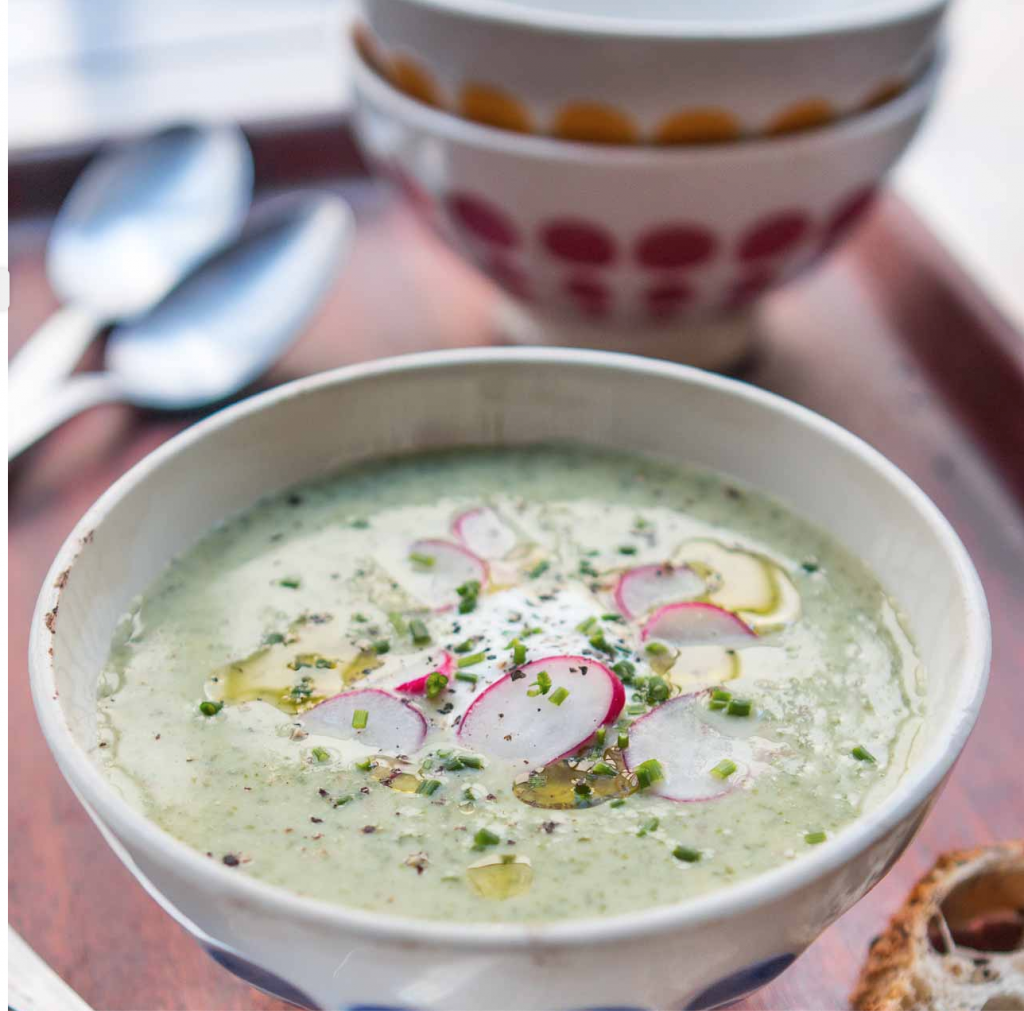
I (that’s David Lebovitz) strongly suggest you use radish leaves that are unsprayed or organic, and wash them well to make sure all grit has been removed. If you don’t have enough radish leaves, feel free to make half the recipe, or bulk it up with lettuce or another mild green. Something like spinach, kale, or Swiss chard will overtake the flavor of the radish leaves (although it’s not the end of the world if you’re trying to use up odds and ends of various greens), but you could use arugula in addition to the radish leaves, or something similar. I don’t peel the potatoes but you are welcome to. If using commercial chicken stock, cut the salt in half and add more, to taste. If you don’t have chicken stock, water or vegetable stock works fine. I added a touch of heavy cream, which smoothed things out nicely and gives the soup a subtle richness, but offered a few alternatives. You could use more, or use regular milk (cow or plant-based), or leave it out. Possible garnishes are, but are not limited to, pumpkin seeds, sliced radishes, crème fraîche, sour cream, olive oil, freshly cracked black or a pinch of red pepper powder, scallions, edible flowers, fresh herbs, a dollop of pesto, or a dribble of pumpkin seed oil.
Ingredients
2 tablespoons butter, salted or unsalted
2 tablespoons olive oil
1 large onion, peeled and diced, or 2 leeks, cleaned and sliced
1 1/2 teaspoons kosher or sea salt
freshly ground black pepper (I used a total of about 1 teaspoon of pepper)
4 cloves garlic, peeled and sliced
2 medium potatoes, washed and diced, (12-16oz, 340-450g)
2 cups (500ml) water
12 cups (lightly packed) fresh radish leaves, rinsed very well (9 oz, 270g)
3 cups (750ml) chicken stock
1 tablespoon Dijon mustard
1/8 teaspoon cayenne pepper
1/2 cup (125ml) heavy cream, sour cream, mascarpone, or creme fraiche
Preparation
- Heat the butter and olive oil in a soup pot or Dutch oven over medium-high heat. Add the onions and cook, stirring frequently, seasoning them with the salt and pepper, until soft and translucent, about 5 minutes. Add the garlic and stir for a minute or two, to help them release their aroma.
- Add the potatoes and 2 cups of water to the pot. Cover, bring to a boil then reduce the heat to a steady simmer and cook until the potatoes are tender when poked with the tip of a sharp paring knife, about 10 to 15 minutes.
- Add the radish leaves and stock. Cover, bring to a boil, then reduce the heat and simmer just until the radish leaves are wilted and cooked through. Remove from heat.
- If using an immersion blender, add the cream, mustard, cayenne, and cream to the pot and puree until smooth. If using a standard blender, let the soup cool until tepid then puree the soup with the cream and mustard. (Never fill a blender more than half full with hot liquid as it can blow off the lid and cause injuries.) Rewarm the soup and serve with any of the suggested garnishes.
Recipe from David Lebovitz, https://www.davidlebovitz.com/radish-leaf-soup-recipe-soupe-fan-radis-recette/.
Rob’s Recipe of the Week: Spring Dal
We’re getting some huge spring greens at the moment and I’ve discovered a few new recipes involving them as a result. I make Dhal fairly regularly but rarely follow a recipe. This one is a really good introduction though, I was quite amazed at how rich it tasted and I’m really not sure what the difference was to my usual attempts! Make sure you cook until the lentils are soft, I’m often too impatient.
Spring Green and Coconut Dal

Ingredients (Serves two)
1 tbsp coconut oil
1 onion, finely sliced
1 large or 2 small garlic cloves, finely chopped, grated or crushed
4cm piece of fresh ginger, peeled and finely grated
1 red chilli, finely sliced
1 tsp black mustard seeds
¼ tsp ground turmeric
1 x 400ml tin coconut milk
100g yellow mung dal lentils, rinsed in a sieve (I used red lentils)
1 tsp coriander seeds, toasted and ground
1 tsp cumin seeds, toasted and ground
200g spring or summer greens, tough ribs removed (sliced them and fired with the onion), leaves finely shredded. Feel free to go heavy on the greens I found they worked well.
handful of coriander leaves
a squeeze of lime or lemon juice
toasted coconut chips or toasted desiccated coconut, to garnish
salt
Method
Prep time: 5 min
Cooking time: 50 min
Melt the coconut oil in a large pan. Add the onion and fry on a low heat for 10 minutes, stirring occasionally.
Turn up the heat a little and add the garlic, ginger, chilli, mustard seeds and turmeric. Stir for about 1 minute, until you hear the mustard seeds start to pop. Stir the coconut milk in the can then pour into the pan with the lentils and ground coriander and cumin. Fill the coconut milk can half full with water and add that too.
Bring up to the boil, reduce the heat and simmer for about 15 minutes. Add the greens, stirring in small handfuls at a time, then cook for a further 5–10 minutes, until the lentils are tender and the greens wilted. Keep an eye on the liquid and add more water if needed.
Season the dal with salt, stir in the fresh coriander and add a squeeze of lime or lemon juice to taste. Serve the dal prinkled with toasted coconut and a few extra coriander leaves.
Adapted from: https://www.riverford.co.uk/recipes/spring-green-and-coconut-dal
Rebecca’s Recipe of the Week: Gingery Green Noodles
This is another very fast dish of delicious slurpy noodles, spiked with basil, lime juice and sesame oil.
Ginger-Poached Noodles
Serves 2-3
Ingredients
4 cups vegetable broth (I used water with 2 tablespoons of white miso)
2 ounces fresh ginger, peeled and thinly sliced
8 ounces firm tofu or tempeh, cut into small cubes
approximately 2 cups of sprouting broccoli or shredded spring greens
4 ounces dried noodles of your choice (I used soba noodles)
1-2 tablespoons soya sauce
¼ cup fresh basil, shredded
¼ cup fresh mint, shredded
juice of half a lime
crushed red pepper flakes (I used part of a shredded Canalside chile)
toasted sesame oil
Preparation
Place the broth and ginger in a large saucepan and bring to a boil. Lower the heat, and simmer gently for ten minutes or so. Meanwhile, bring some water to the boil to cook the noodles.
Cook the noodles in the boiling water until they are tender, drain them, and set them aside.
After the broth has simmered for ten minutes add the and tofu or tempeh and the greens. Return to a boil, and then turn the heat back down to a simmer and cook for 5-8 minutes, or until the greens are tender.
Add the drained pasta to the broth and heat for a few more minutes, stirring regularly. Stir in the soya sauce, basil, mint, and lime juice. Before serving, if you have the energy you can fish out the slices of ginger, which are perfectly edible but a bit chewy.
Serve in bowls with a few pinches of crushed red pepper flakes, and a drizzle of sesame oil, to taste.
Recipe adapted from 101 Cookbooks.
Rob’s Recipe of the Week: A Dish Full of Pink
We’ve had a whole lot of beetroot to contend with this winter and I’m still trying to find new ways to use it. This recipe seemed very lockdown themed as I imagine a lot of people have been trying out sourdough bread for the first time. I’m not a big fan myself but combined with a beetroot gratin I can give it a chance!
Beetroot and pink peppercorn gratin
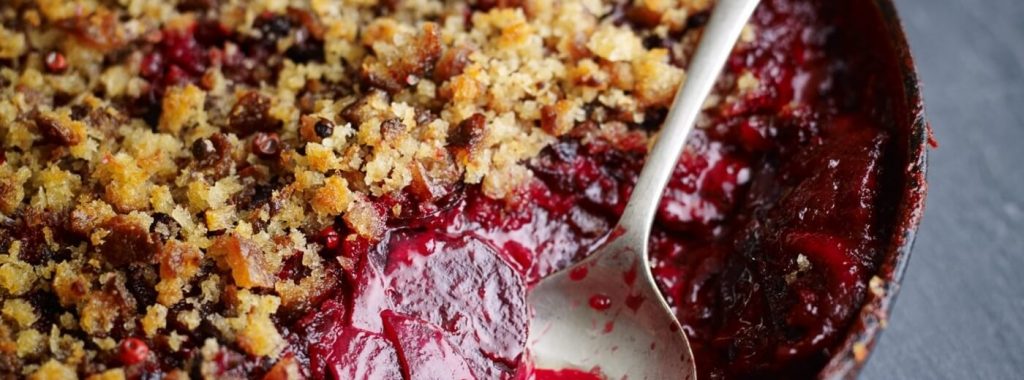
As good with roast beef for Sunday lunch as it is a smart veggie main. The pink peppercorns add an extra rosy zing, but just use normal black pepper if you can’t find them.
Serves 6 (Scale the recipe to match your share size.)
Ingredients
1.5kg beetroot, peeled
4 garlic cloves
250ml double cream
2 slices of day-old sourdough bread
40g butter, chilled, diced
Olive oil
3 tbsp finely ground pink peppercorns
Red wine vinegar
Salt and black pepper
Method:
1 Preheat the oven to 180C/350F/gas mark 4. Thinly slice the beetroot either by hand or using a mandolin.
2 Give the garlic cloves a good bash and pop them in a pan with the cream, slowly bring to the boil, simmer gently for 10 minutes and then leave to infuse for a further 10 minutes.
3 Sieve the cream on to the beetroot, pressing the garlic with the back of a spoon to extract the flavour. Season generously with salt and mix well.
4 Pack the beetroot into an ovenproof roasting dish. Cover tightly with foil. Bake for anywhere between 30-45 minutes (it will depend on the age and season of the beetroots) or until it yields easily to the tip of a knife.
5 Cut the crusts from your sourdough and blend the insides into a coarse crumb, add the cold butter and a small glug of olive oil and pulse again, as though you’re making a crumble topping.
6 Remove foil and stir in the pink peppercorns, a dash of red wine vinegar to taste and check the seasoning. Arrange in a gratin dish and sprinkle with the breadcrumbs. Bake until golden brown on top and bubbling.
Rob Andrew, Riverford Field Kitchen, https://www.riverford.co.uk/recipes/beetroot-and-pink-peppercorn-gratin
Featured in Guardian Food, 10 Best Beetroot Recipes https://www.theguardian.com/lifeandstyle/2014/may/24/10-best-beetroot-recipes
Rebecca’s Recipe of the Week: Superlative Parsnips
This is EXACTLY what you need to eat on Easter Sunday.* Whatever else you’re serving, this will make it even better. The recipe comes from Abra Berens, who recommends accompanying it with grilled duck breast and radicchio. It’s also pretty super spread on a piece of toast.
Parsnip Purée
Serves 4.
Ingredients
120ml olive oil
1 large onion, peeled and cut into thin slices
250ml white wine
900g parsnips, peeled and cut into chunks
2 teaspoons salt
250ml double cream (although we in fact substituted oatmilk)
2 star anise
Zest of one orange
Preparation
In a medium saucepan, heat a generous glug of the oil over very low heat. Add the onion and cook until very soft, for about 15 minutes.
Add the wine, and continue to cook until it’s almost completely evaporated.
Add the parsnips and salt, and toss together.
Add the cream, the remaining olive oil, and star anise. Bring to a boil, the reduce the heat so that the mixture simmers gently. Cover and cook until the parsnips are falling-apart tender, about 15 minutes more. Remove the star anise.
Purée the mixture (liquid and all) until it is very smooth. Add the orange zest and enjoy.
Recipe adapted from Abra Berens, Ruffage: A Practical Guide to Vegetables (2019).
*I expect you can work it into a Seder as well…
Rob’s Recipe of the Week: Lasagne with a difference
I can rarely bring myself to make lasagne but this recipe has got me interested. The question is whether the shops will actually have lasagne sheets in stock but fingers crossed!
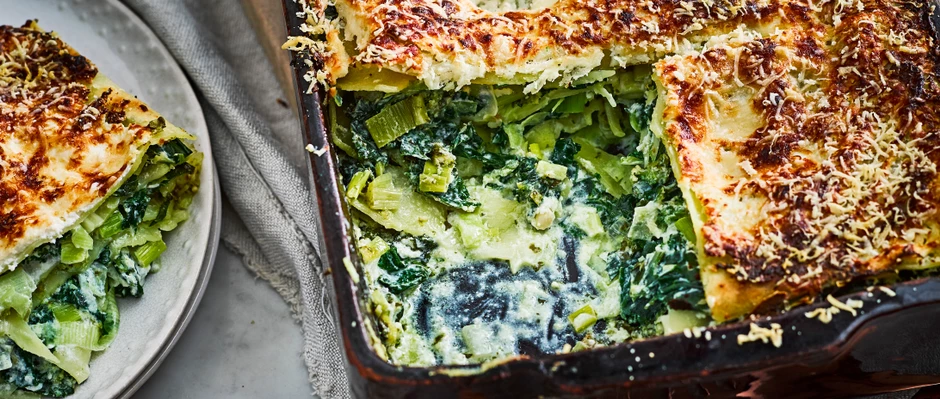
Kale, ricotta and leek lasagne
Ingredients
kale 300g, woody stems removed and leaves chopped
olive oil 1 tbsp
trimmed leeks 3 (about 400g), halved lengthways, washed and chopped
garlic 1 clove, crushed
ricotta 350g (try vegan version from https://www.bosh.tv/recipes/spicy-creamy-cannelloni)
vegetable stock 150ml
fresh pesto 4 tbsp
fresh lasagne 250g, about 8 sheets
parmesan (or veggie alternative) 30g, finely grated
Method
Heat the oven to 200C/fan 180C/gas 6. Drop the kale in boiling salted water, bring back to a simmer then cook for 5 minutes. Drain really well.
Heat the olive oil in a frying pan and add the leeks with a good pinch of salt. Cook for 8-10 minutes or until really soft.
Add the garlic to the leeks and cook for 2 minutes. Keep 4 tbsp of the ricotta aside then stir the rest into the leeks with the kale. Mix everything well then add enough vegetable stock to make it a little saucy but not watery. Take off the heat.
Put a 1/4 of the sauce in the bottom of an oiled baking dish approximately 18 x 25cm. Top with 1 tbsp pesto then 2 sheets of lasagne. Repeat 3 times, ending with lasagne.
Mix the rest of the ricotta with another splash of vegetable stock and spread over the top layer. Scatter over the parmesan and bake for 20 minutes until golden and bubbling.
From: https://www.olivemagazine.com/recipes/vegetarian/kale-ricotta-and-leek-lasagne/
Erica’s Recipe of the Week: Sweet, rich and sour Indian vegetable stew
Thanks to Erica Moody for suggesting this recipe from Meera Sodha’s column in last week’s Guardian Food.
Meera says: There might seem to be a lot of chillies in this, but it’s not a hot dish, because the natural sweetness of the squash and sweetcorn, combined with the rich coconut milk and spiky lime, balance things out. Fresh curry leaves are now sold in most major supermarkets.
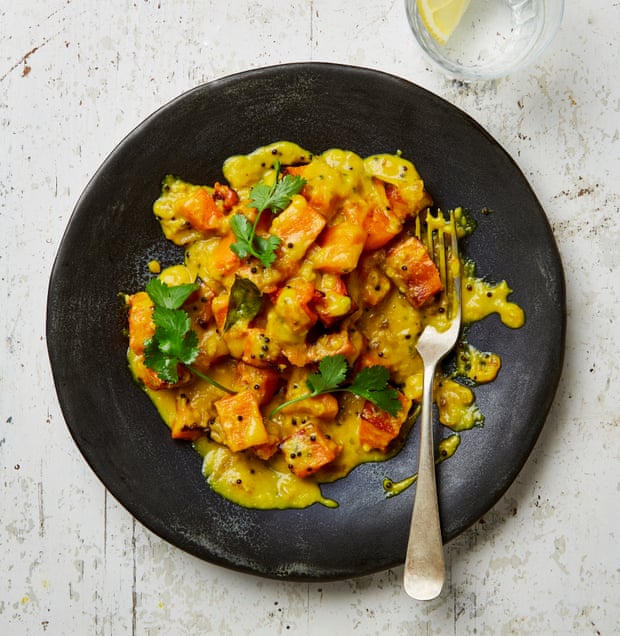
Butternut squash and sweetcorn erriseri
Prep 10 min
Cook 45 min
Serves 4
Ingredients:
1kg squash, washed
Sunflower oil
Fine sea salt
1 x 340g tin sweetcorn, drained
2 tsp black mustard seeds
12 curry leaves
1 large onion, peeled and finely chopped
4 garlic cloves, peeled and minced
3 green finger chillies, finely chopped
2 tsp turmeric
1 x 400ml tin coconut milk
2 tbsp fresh lemon juice (ie, from 1 lemon)
Coriander leaves, to garnish
Method:
Cut the squash in half (no need to peel), scoop out and discard the seeds, then cut it into 2cm cubes. Heat the oven to 200C (180C fan)/gas 6. Tip the squash pieces on to an oven tray, pour over two tablespoons of oil and a good sprinkling of salt, and toss to coat. Bake for 25-30 minutes, until the squash chunks are tender and their edges caramelised.
Add two tablespoons of water to the drained sweetcorn kernels and blend to a smooth paste (I use a stick blender).
In a large frying pan, heat two tablespoons of oil and, when hot, add the mustard seeds and curry leaves, and leave them to crackle and pop for a minute. Now add the onion and cook, stirring occasionally, for about 10 minutes, until translucent and turning golden, then add the garlic and chillies, and cook for two minutes. Stir in the sweetcorn paste, turmeric and a teaspoon and a half of salt, cook for a minute, then add the coconut milk (keep the tin) and whisk so everything is combined and the curry sauce is a vibrant yellow.
Half-fill the coconut milk tin with water and add to the pot to loosen the curry – you may need a little more or less water than this, depending on the thickness of your coconut milk – bring to a boil and simmer for five minutes, until it starts to thicken. Stir in the roast squash and lemon juice, and check the seasoning. Garnish with coriander and serve immediately.
Adapted from Guardian Food, 20th March 2020
Rob’s Recipe of the Week: ‘Spring on the way’ soup
I haven’t used a soup recipe for a while and I’ve suddenly realised I’ve been surviving off beans and toast for lunch for a little too long, We have an abundance of leeks at the moment and I could go for the easy option of leek and potato soup, but thought I would try this slightly different idea instead.
Leek, spring green and apple soup
Ingredients:
25g butter
1 tbsp olive oil
1 large onion, finely sliced
600g leeks (about 3-4 large), finely shredded
2 garlic cloves, crushed
2 apples, peeled and diced
250ml cider
1 litre veg stock
100g spring greens, finely shredded
salt and pepper
Method
Heat the butter and oil in a large pan. Add the onion and leeks. Fry on a low heat for 10 minutes. Add the garlic and apple and cook for 2 minutes. Add the cider and simmer for 5 minutes.
Add the stock, bring to the boil, reduce the heat and simmer for 10 minutes.
Add the spring greens and simmer for 5 minutes, or until the greens are tender. Blitz until smooth or leave chunkier, whichever you prefer.
Season, and serve.
Taken from: https://www.riverford.co.uk/recipes/view/recipe/leek-spring-green-apple-soup
Rob’s Recipe of the Week: Beetroot – something a little different…
In the summer I went biking in the alps and was lucky enough to stay at a chalet hosted by an ex-River cottage and Heston Blumenthal employed chef (White Room MTB if anyone is interested). Every afternoon we would return to find cake ready and waiting for us and the beetroot chocolate cake below was so good I had to ask Matty to put it up on his blog!

Beetroot brownie cake
Ingredients for the cake – This makes two 8-inch cake tins:
125 g dark chocolate (70% or over)
125 g unsalted butter
2 whole eggs
125 g caster sugar
1 large grated beetroot
95 g flour
40 g pure cocoa powder
1 tsp baking powder
1 tbs Butter & flour for greasing your cake tins or use baking paper.
Method:
Pre heat your oven to 175°c. Grease and line 2 x 8 inch cake tins with butter and flour or baking paper.
Gently melt butter and chocolate together using a double boiler or a microwave until melted.
Meanwhile using an electric mixer whip the sugar and eggs until light and fluffy.
Pour the melted butter and chocolate mixture into the whipped eggs and continue beating for about a minute.
Then grate a large beetroot into the mixture and stir until all incorporated.
Sift in the dry ingredients into the wet ingredients and mix until all incorporated.
Divide the mix into both cake tins and bake for about 25 to 35 minutes depending on your oven. When the cake is ready it will be soft but not a raw liquid wobble if you know what I mean. If it’s still batter keep it cooking.
Once cooked take out of the oven and let it cool on the side until ready to garnish.
This cake is good as is. However covering anything with cream and more chocolate will always be better 😂😉
Assemble as you like and enjoy. Bon Appetit! Xx
From https://www.mattygcooks.com/post/beetroot-brownie-cake
Rebecca’s Recipe of the Week: Pink Pickled Turnips (or Spanish Radish)
Dishes of pickled turnips often accompany the mezzes at a Middle Eastern restaurant (or, probably, a Middle Eastern meal). Salty and pink, they are easy to make at home. You can substitute those confusing giant Spanish black radishes for the turnips, if you still have some of these in your fridge. The lovely pink colour comes from beetroot.
The ratio of turnip to beetroot is approximate.
You can sterilise jars by placing clean washed jars in a 130C oven for 20 minutes. Switch the oven off and leave the jars inside until needed. Alternatively, pour boiling water over clean jars and leave until you’re ready to use them.
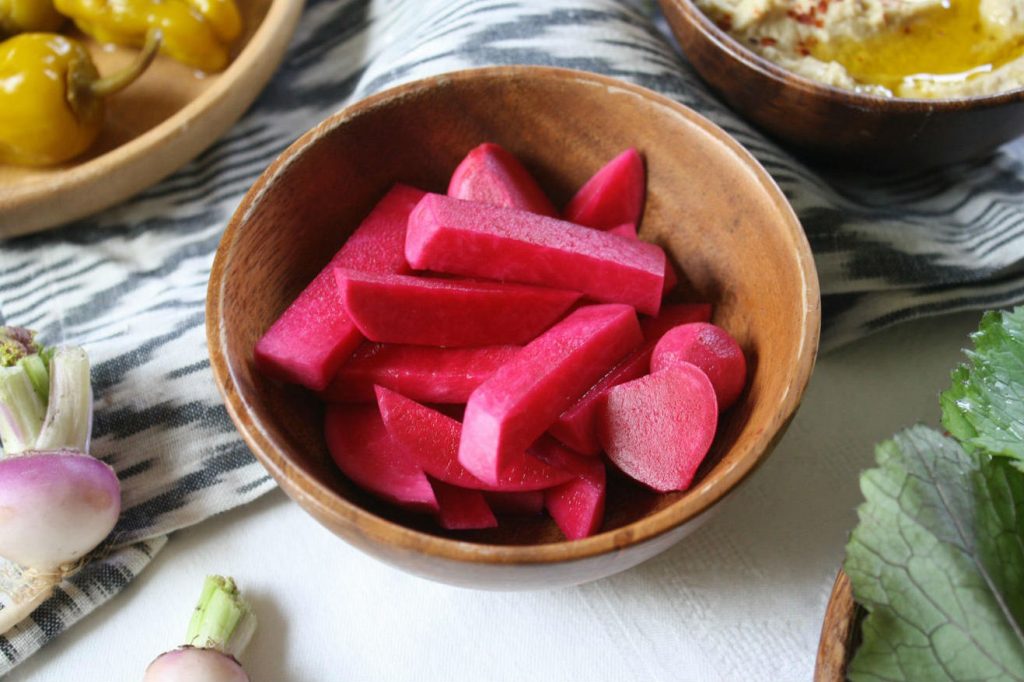
Pink Pickled Turnips
Ingredients
500ml water
3 tablespoons salt
1.5 kilos turnips or Spanish black radishes, or a mixture
250g beetroot
3-4 cloves of garlic
Handful of celery leaves
A few bay leaves (optional)
1 teaspoon whole peppercorns (optional)
2 cups white vinegar
Preparation
Boil the water and salt together for 5 minutes, then set aside to cool.
Peel the turnips or radishes, and the beetroot, and cut into wedges. (The size does not matter a great deal; cut them into the size you’d like to eat.) Peel the garlic and cut each clove in half.
Layer the turnips (or radishes) in sterilised jars, packing some garlic, celery leaves, and optional bay leaves and peppercorns in between each layer.
Combine the vinegar with the water-and-salt mixture and pour this over the vegetables. Poke the vegetables down with a spoon to ensure there are no air pockets and that the vegetables are fully submerged. Seal the jar—Sally Butcher recommends putting a layer of clingfilm over the top before sealing if you’re using a metal lid—and leave for at least 2 weeks and up to 6 months.
Recipe adapted from Sally Butcher, Veggistan: A Vegetable Lover’s Tour of the Middle East (2011).